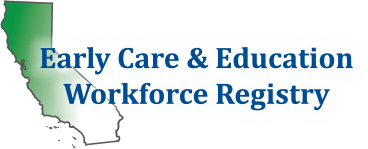Early Learning Workforce Stipend Programs
Registry Members can apply for various state and local stipend programs (e.g. county Workforce Pathways Grants) using the Registry.
If you are located in a county which offers stipend programs in partnership with the Registry, you will see the stipend listed in your county’s stipends programs.
How to Apply:
Step 1 – Login to the Registry at www.caregistry.org
If you already have a Registry account
Login to your account using your email address and update your personal and/or employment details on My Tools & Settings
If you do NOT have a Registry account
Step 2 – Click on “Stipends & Pathways”
Locate the county in which you plan to apply for a stipend (if you are not sure please contact your local county stipend administrator)
Click on Application and begin the process

Workforce Pathway Advisors
Workforce Pathways Advisors work with ELC professionals using the ECE Workforce Registry to search for and enroll in trainings, track PD progress, and maintain a profile with qualification data. Participant resources are available on the Resource Page and include instructions on creating a profile, enrolling and withdrawing from trainings, how to apply for stipends, and how to use the Job Board.
Tips sheets designed to be used with a Workforce Pathways Advisor include:
- Complete Profile Checklist (most resources available in English, Chinese, and Spanish)
- Maximize the Benefit of Using the Registry
- QCC Quality Improvement Plan
Resources for Advisors and Higher Education Facility

Advising Guidance
Ensure all members of the workforce receiving support through the QCC Workforce Pathways Grant meet with an advisor to develop a Professional Development (PD), Professional Growth, or Education Plan and maintain a CA ECE Workforce Registry profile.[1] The advisor will ensure that members of the workforce participating in the QCC Workforce Pathways Grant have an attainable plan to complete a course of study that effectively and efficiently meets their education goals. These advisory duties could be completed by existing advisors (e.g., at university or community college settings) or at the local level with efforts that may include: Providing frequent (e.g., monthly) and ongoing support that uses a case management approach and supports each educator throughout their educational trajectory and professional development and set clear professional learning and continuous quality improvement goals.
- Assisting students to meet requirements to advance up the Child Development Permit Matrix
- Ensuring that all participants who engage in college courses utilize higher education advising on pathways and course sequencing in alignment with California Community Colleges Guided Pathways efforts. For more information regarding Guided Pathways efforts at California Community Colleges, please see the Guided Pathways website.
- Advising that connects the workforce to all available financial supports to appropriate college personnel (e.g., Free Application for Federal Student Aid (FAFSA), California College Promise Grant, formerly known as the Board of Governors (BOG) Fee Waiver, local funding, etc.)
- Facilitating student transfers from Associate of Arts (AA) to Bachelor of Arts (BA) programs
- Providing higher education advising on general education coursework that is best suited to the ELC workforce [2]

- QCC Workforce Pathways PD plans must include a section to establish personal goals and objectives. If using a standard form that does not capture those components, an addendum will need to be added.
- Proactive advising, sometimes called “intrusive” advising, is the idea that rather than waiting for students to come looking for advising, advisors have regular check-ins with students based on their levels of need. This can be differentiated in terms of frequency, type of check-in (e.g., email or meeting), and the topics in which a student receives advising.


